Get free scan and check if your device is infected.
Remove it nowTo use full-featured product, you have to purchase a license for Combo Cleaner. Seven days free trial available. Combo Cleaner is owned and operated by RCS LT, the parent company of PCRisk.com.
What kind of malware is Aesimus?
Aesimus, a nefarious variant of the Autolycos malware, wreaks havoc on Android users. Cybercriminals employ deceptive tactics, camouflaging Aesimus within seemingly innocuous creativity applications to lure users. Once infiltrated, this insidious software triggers premium service purchases, inflicting financial harm on unsuspecting victims.
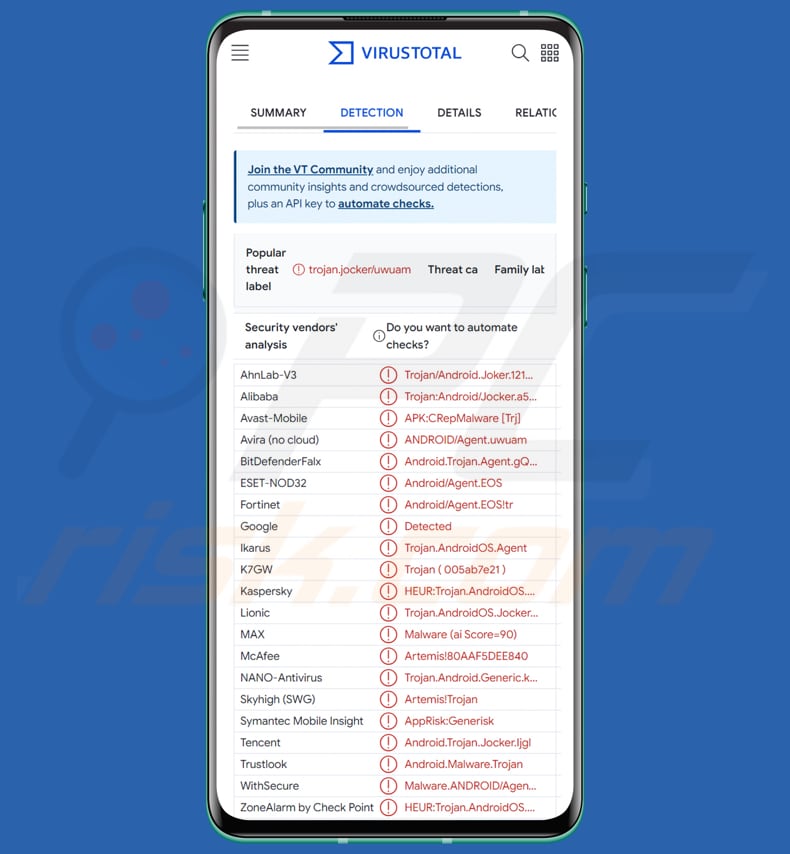
Aesimus in detail
The Aesimus malware operates stealthily, utilizing a native library to conceal its presence within the Android ecosystem. Its execution process is meticulously crafted to evade detection, first by verifying that the target device is not rooted and is devoid of reverse engineering tools.
Additionally, it scrutinizes the app's source, checking if it has been downloaded from an advertisement. Once these prerequisites are met, the malware springs into action, initiating the download of a file harboring its malicious payload, often disguised by an innocuous image URL.
To propagate its malevolent agenda, cybercriminals behind Aesimus employ fraudulent tactics, orchestrating Google Ads campaigns to promote seemingly legitimate applications. Through this manipulative strategy, they swiftly ascend the rankings within the Google Play Store, thus widening their potential victim pool.
Notable among the apps known to harbor this clandestine threat are Pixel Brush, Oil, Watercolor Painting, Paint Board, and Pixel Creation, unsuspectingly serving as conduits for the dissemination of Aesimus and perpetuating its detrimental impact on unsuspecting users.
Since the Aesimus malware subscribes to premium services, it means that once it successfully infects a device, it initiates unauthorized subscriptions to various paid services without the user's consent or knowledge. These premium services could include subscription-based apps, content streaming platforms, gaming services, or other digital products that require recurring payments.
By subscribing to these services using the victim's credentials or payment information, the malware generates financial gain for the cybercriminals behind it while burdening the victim with unexpected charges and potentially compromising their personal and financial security.
| Name | Aesimus malicious application |
| Threat Type | Android malware, malicious application, unwanted application. |
| Detection Names | Avast-Mobile (APK:CRepMalware [Trj]), Combo Cleaner (Android.Trojan.Agent.gQNTJ), ESET-NOD32 (Android/Agent.EOS), Kaspersky (HEUR:Trojan.AndroidOS.Jocker.wx), Full List Of Detections (VirusTotal) |
| Possible Symptoms | The device is running slow, system settings are modified without user's permission, questionable applications appear, data and battery usage is increased significantly, browsers redirect to questionable websites, intrusive advertisements are delivered. |
| Distribution methods | Trojanzied apps on Google Play, malicious Google Ads campaigns, social engineering, deceptive applications. |
| Damage | Subscriptions to premium services, monetary losses. |
| Malware Removal (Windows) |
To eliminate possible malware infections, scan your computer with legitimate antivirus software. Our security researchers recommend using Combo Cleaner. Download Combo CleanerTo use full-featured product, you have to purchase a license for Combo Cleaner. 7 days free trial available. Combo Cleaner is owned and operated by RCS LT, the parent company of PCRisk.com. |
Conclusion
In conclusion, the Aesimus malware employs deceptive tactics to infiltrate devices and perpetrate malicious activities. By concealing itself within native libraries and employing intricate execution processes to avoid detection, Aesimus can clandestinely wreak havoc on unsuspecting victims.
Its ability to subscribe users to premium services without their consent underscores the severity of its impact, leading to financial losses and eroding trust in digital platforms. As cybercriminals evolve their tactics, users must remain vigilant, employ robust security measures, and stay informed about emerging threats to safeguard them from the effects of malware like Aesimus.
More examples of malware targeting Android users are Joker, VajraSpy, and Xamalicious.
How did Aesimus infiltrate my device?
Users unwittingly fall victim to this malware when they download and install seemingly legitimate applications from sources like the Google Play Store, unaware of the hidden threats lurking within those apps. The perpetrators behind Aesimus resort to deceitful methods, orchestrating Google Ads campaigns to endorse seemingly genuine applications.
This cunning approach enables them to rapidly climb the ranks within the Google Play Store, consequently broadening their scope of potential victims.
Also, sideloading apps from third-party sources and clicking on suspicious links or ads pose significant risks. Compromised Wi-Fi networks and social engineering tactics like phishing also contribute to the spread of malware.
How to avoid installation of malware?
Ensure Google Play Protect is activated; this built-in security feature scans apps for malware and offers additional protection. Stick to downloading apps exclusively from official app stores like Google Play Store, refraining from sideloading from third-party sources. Prioritize reading reviews before app installation.
Exercise caution when interacting with links or advertisements, particularly those from unfamiliar or dubious origins. Opt for secure Wi-Fi networks and steer clear of public connections lacking proper security protocols. Keep your device's operating system and apps up to date.
Remain vigilant against social engineering tactics like phishing emails or messages, refraining from divulging sensitive information, or clicking on dubious links. Safeguard your device with reputable antivirus or security software.
Trojanized app on Google Play utilized to hide Aesimus:
![]()
Quick menu:
- Introduction
- How to delete browsing history from the Chrome web browser?
- How to disable browser notifications in the Chrome web browser?
- How to reset the Chrome web browser?
- How to delete browsing history from the Firefox web browser?
- How to disable browser notifications in the Firefox web browser?
- How to reset the Firefox web browser?
- How to uninstall potentially unwanted and/or malicious applications?
- How to boot the Android device in "Safe Mode"?
- How to check the battery usage of various applications?
- How to check the data usage of various applications?
- How to install the latest software updates?
- How to reset the system to its default state?
- How to disable applications that have administrator privileges?
Delete browsing history from the Chrome web browser:
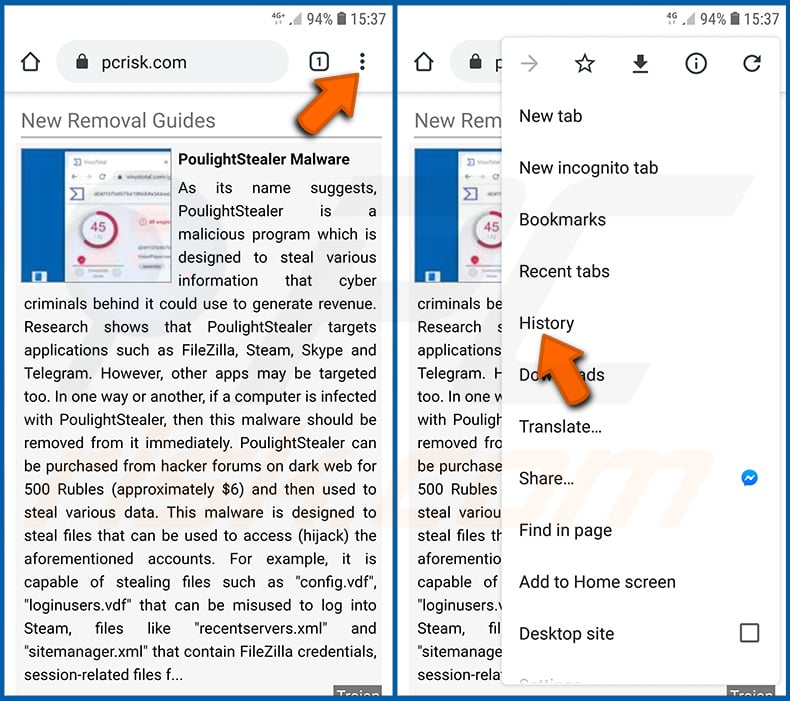
Tap the "Menu" button (three dots on the right-upper corner of the screen) and select "History" in the opened dropdown menu.

Tap "Clear browsing data", select "ADVANCED" tab, choose the time range and data types you want to delete and tap "Clear data".
Disable browser notifications in the Chrome web browser:
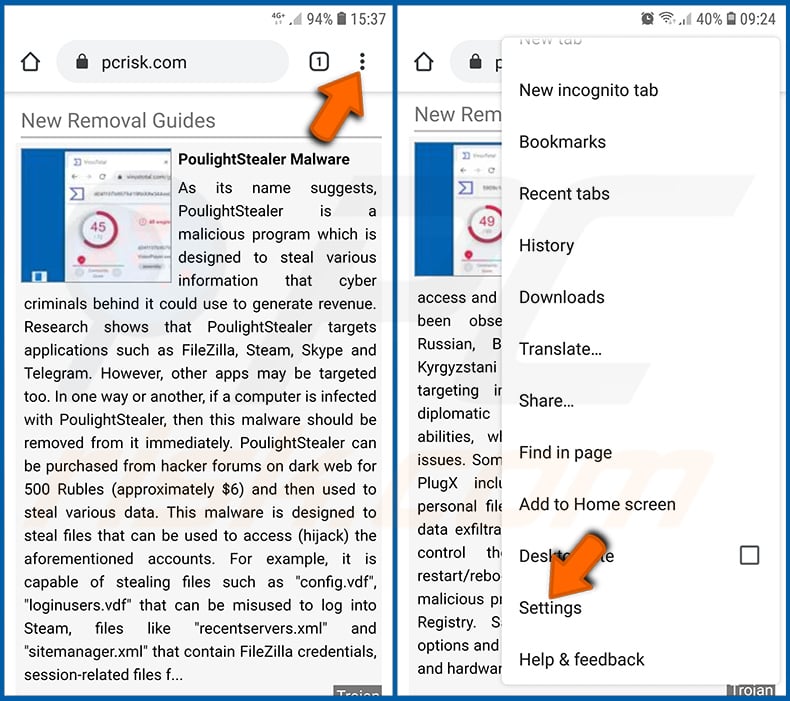
Tap the "Menu" button (three dots on the right-upper corner of the screen) and select "Settings" in the opened dropdown menu.
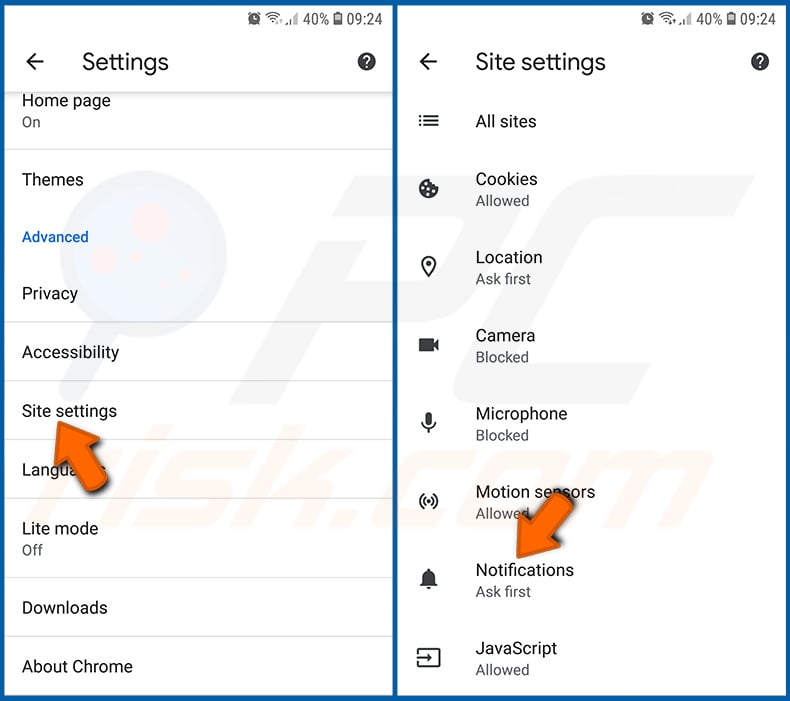
Scroll down until you see "Site settings" option and tap it. Scroll down until you see "Notifications" option and tap it.
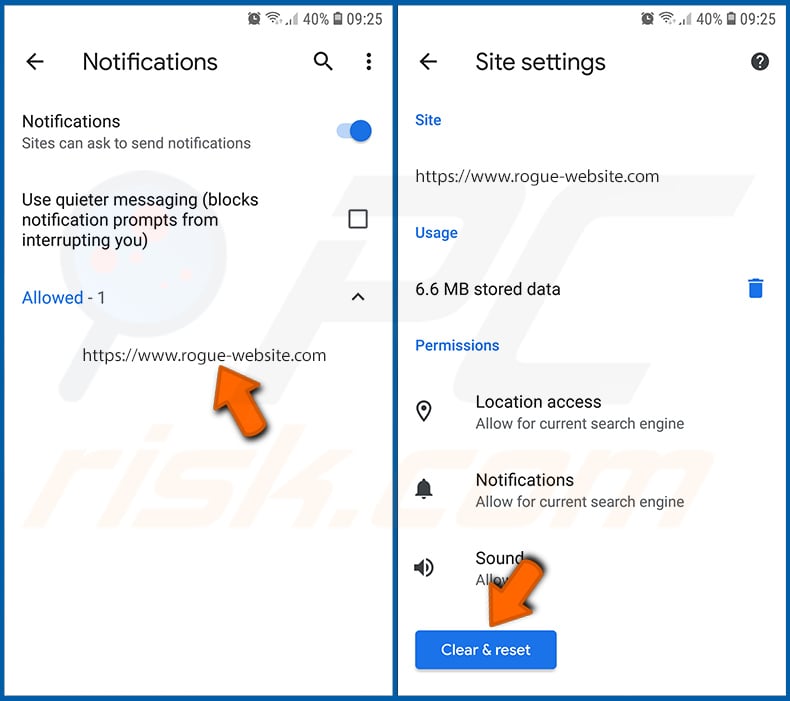
Find the websites that deliver browser notifications, tap on them and click "Clear & reset". This will remove permissions granted for these websites to deliver notifications. However, once you visit the same site again, it may ask for a permission again. You can choose whether to give these permissions or not (if you choose to decline the website will go to "Blocked" section and will no longer ask you for the permission).
Reset the Chrome web browser:
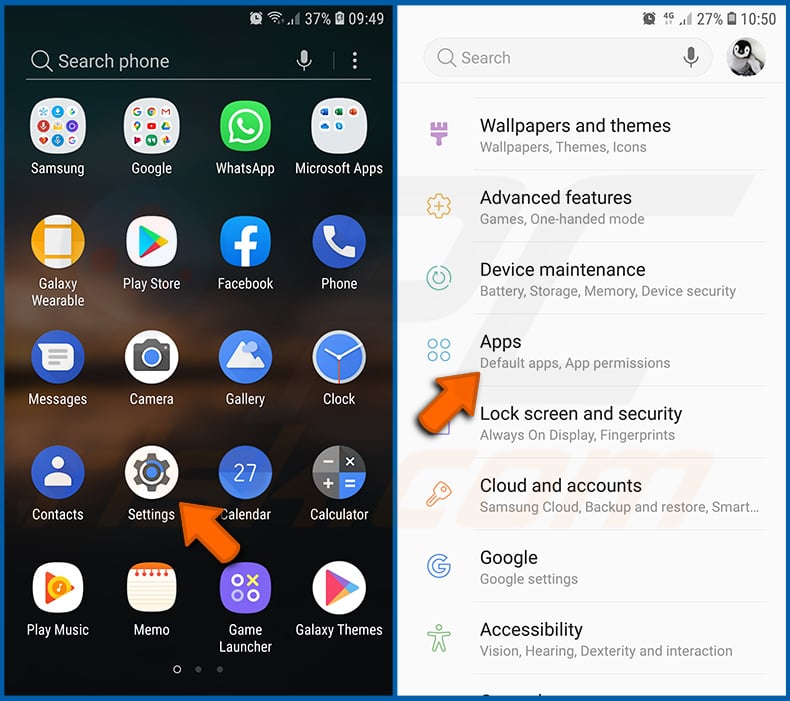
Go to "Settings", scroll down until you see "Apps" and tap it.
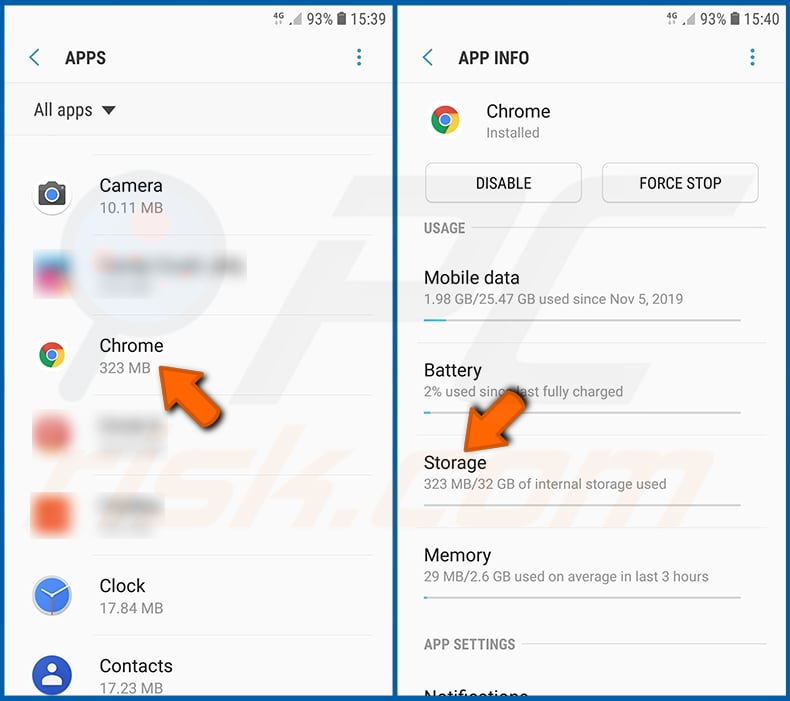
Scroll down until you find "Chrome" application, select it and tap "Storage" option.
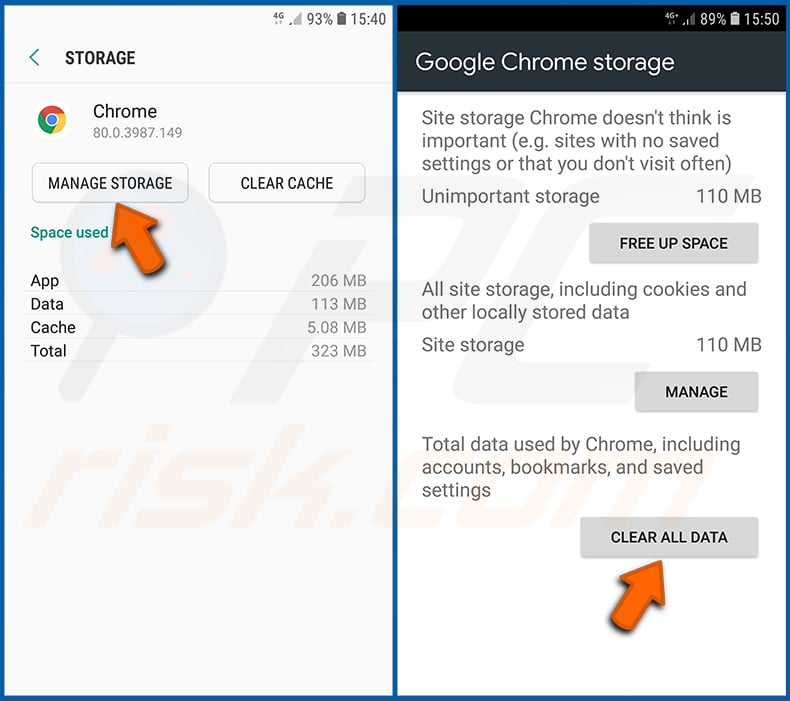
Tap "MANAGE STORAGE", then "CLEAR ALL DATA" and confirm the action by taping "OK". Note that resetting the browser will eliminate all data stored within. This means that all saved logins/passwords, browsing history, non-default settings and other data will be deleted. You will also have to re-login into all websites as well.
Delete browsing history from the Firefox web browser:
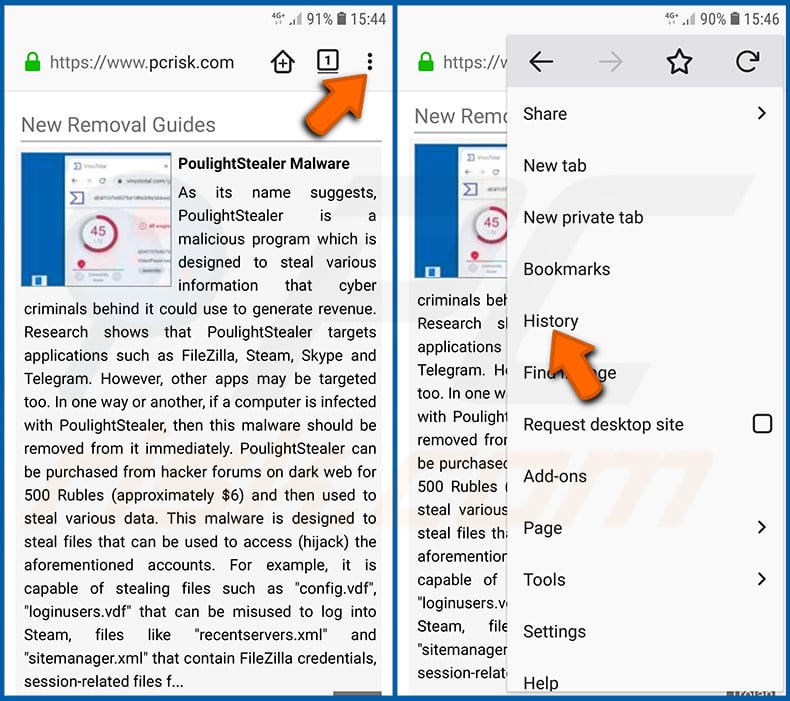
Tap the "Menu" button (three dots on the right-upper corner of the screen) and select "History" in the opened dropdown menu.
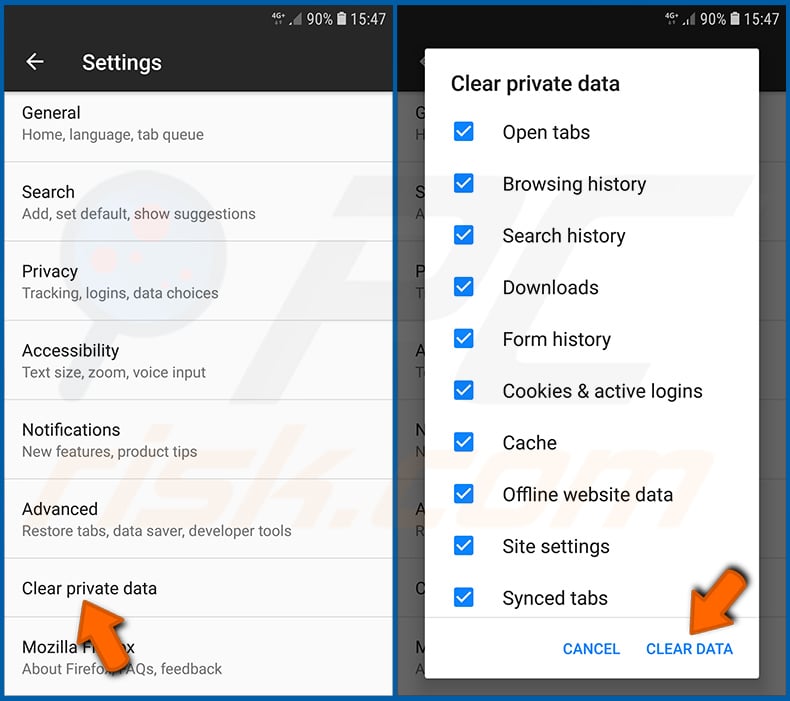
Scroll down until you see "Clear private data" and tap it. Select data types you want to remove and tap "CLEAR DATA".
Disable browser notifications in the Firefox web browser:
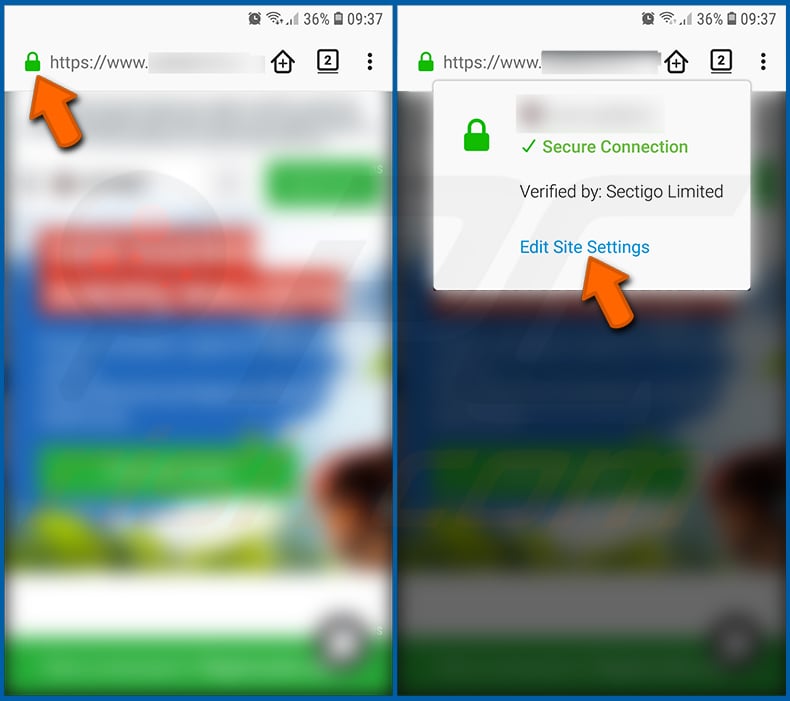
Visit the website that is delivering browser notifications, tap the icon displayed on the left of URL bar (the icon will not necessarily be a "Lock") and select "Edit Site Settings".
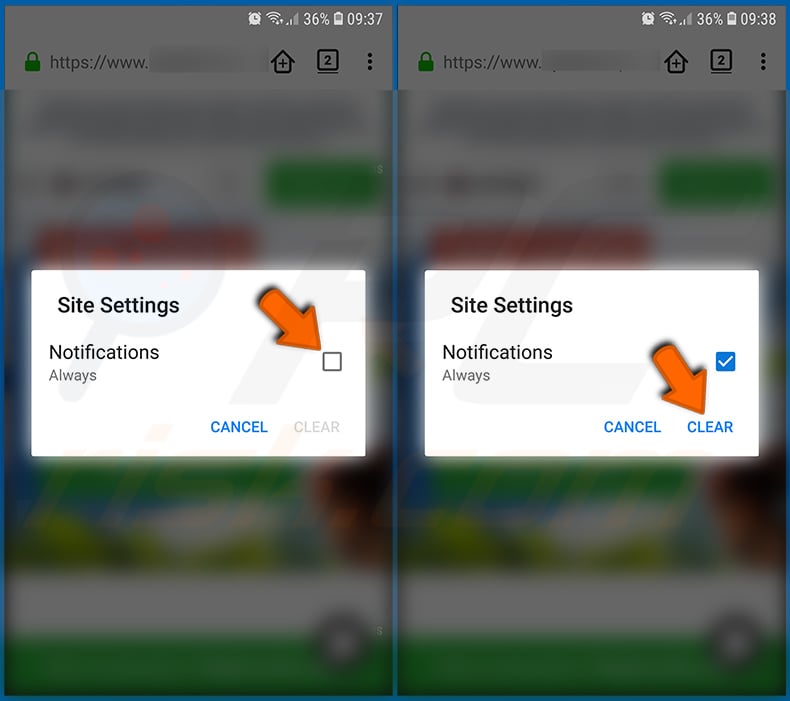
In the opened pop-up opt-in the "Notifications" option and tap "CLEAR".
Reset the Firefox web browser:
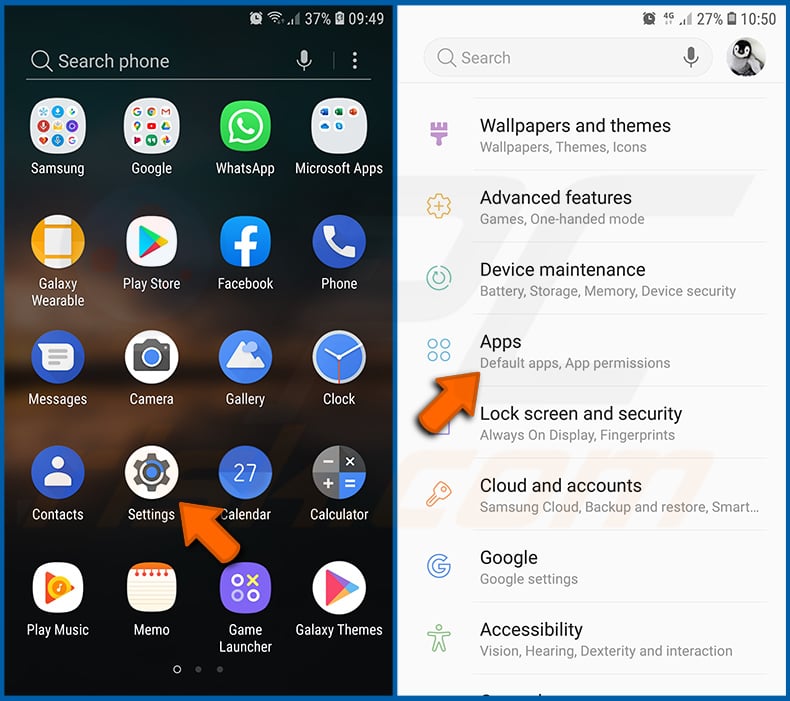
Go to "Settings", scroll down until you see "Apps" and tap it.
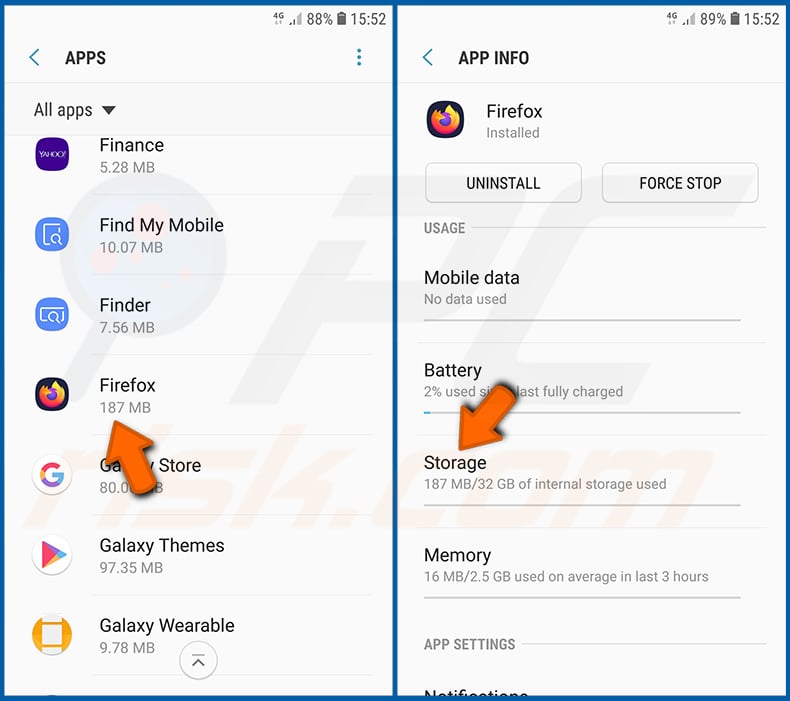
Scroll down until you find "Firefox" application, select it and tap "Storage" option.
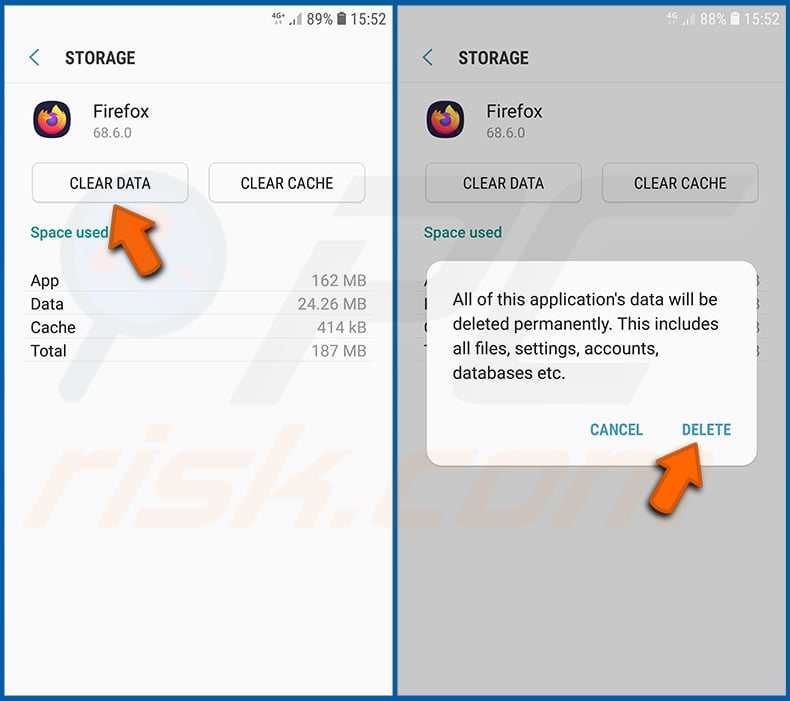
Tap "CLEAR DATA" and confirm the action by taping "DELETE". Note that resetting the browser will eliminate all data stored within. This means that all saved logins/passwords, browsing history, non-default settings and other data will be deleted. You will also have to re-login into all websites as well.
Uninstall potentially unwanted and/or malicious applications:
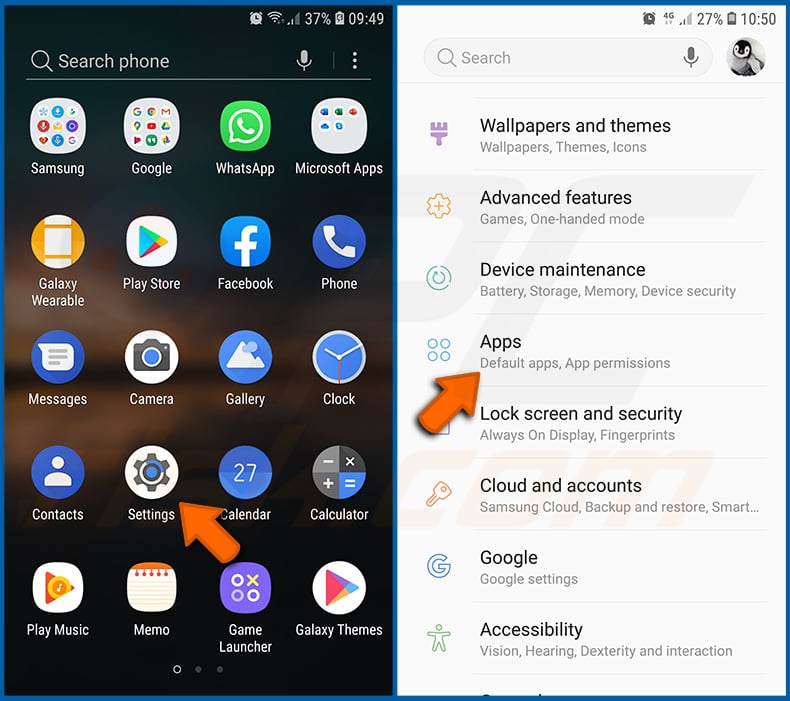
Go to "Settings", scroll down until you see "Apps" and tap it.
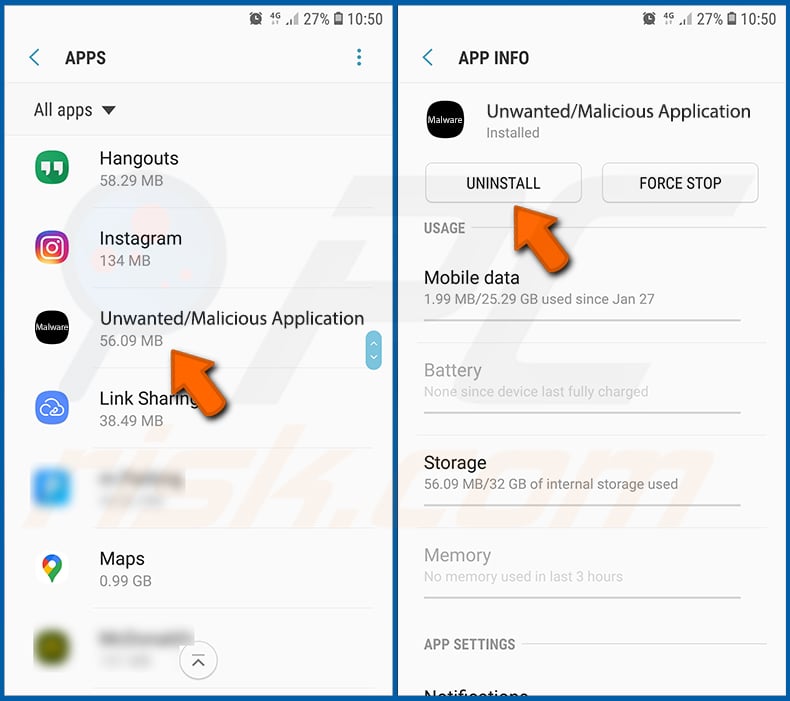
Scroll down until you see a potentially unwanted and/or malicious application, select it and tap "Uninstall". If, for some reason, you are unable to remove the selected app (e.g., you are prompted with an error message), you should try using the "Safe Mode".
Boot the Android device in "Safe Mode":
The "Safe Mode" in Android operating system temporarily disables all third-party applications from running. Using this mode is a good way to diagnose and solve various issues (e.g., remove malicious applications that prevent users you from doing so when the device is running "normally").
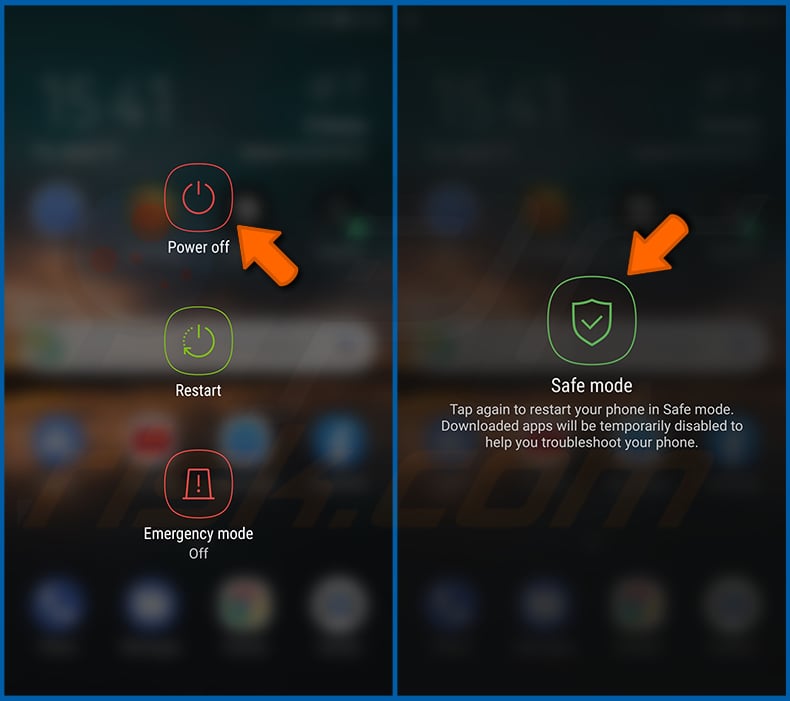
Push the "Power" button and hold it until you see the "Power off" screen. Tap the "Power off" icon and hold it. After a few seconds the "Safe Mode" option will appear and you'll be able run it by restarting the device.
Check the battery usage of various applications:
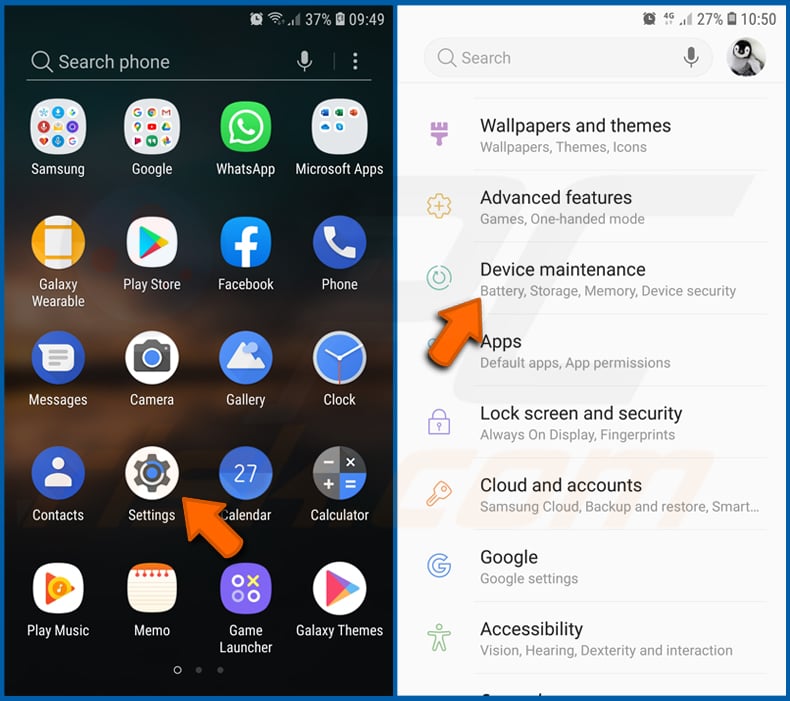
Go to "Settings", scroll down until you see "Device maintenance" and tap it.
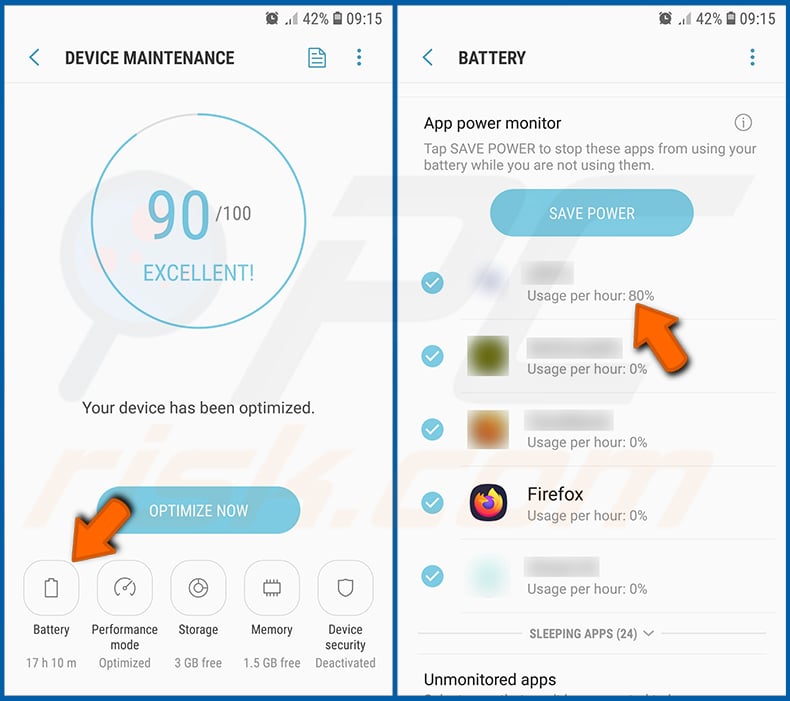
Tap "Battery" and check the usage of each application. Legitimate/genuine applications are designed to use as low energy as possible in order to provide the best user experience and to save power. Therefore, high battery usage may indicate that the application is malicious.
Check the data usage of various applications:
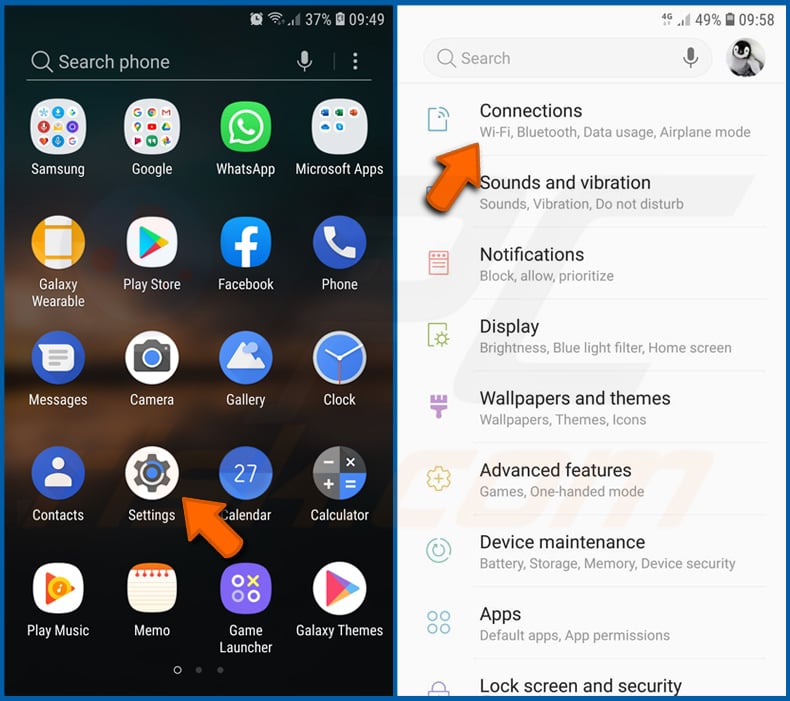
Go to "Settings", scroll down until you see "Connections" and tap it.
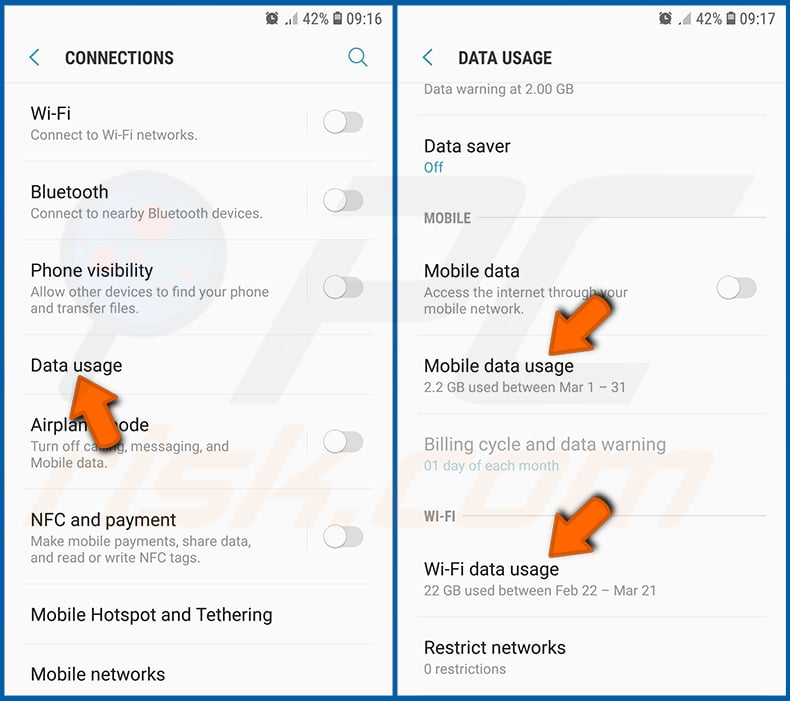
Scroll down until you see "Data usage" and select this option. As with battery, legitimate/genuine applications are designed to minimize data usage as much as possible. This means that huge data usage may indicate presence of malicious application. Note that some malicious applications might be designed to operate when the device is connected to wireless network only. For this reason, you should check both Mobile and Wi-Fi data usage.
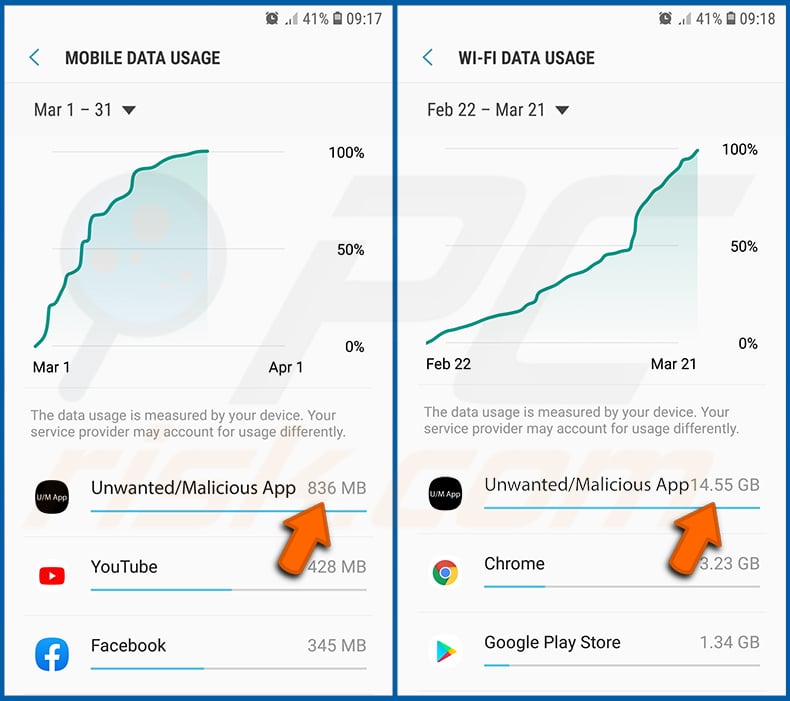
If you find an application that uses a lot of data even though you never use it, then we strongly advise you to uninstall it as soon as possible.
Install the latest software updates:
Keeping the software up-to-date is a good practice when it comes to device safety. The device manufacturers are continually releasing various security patches and Android updates in order to fix errors and bugs that can be abused by cyber criminals. An outdated system is way more vulnerable, which is why you should always be sure that your device's software is up-to-date.
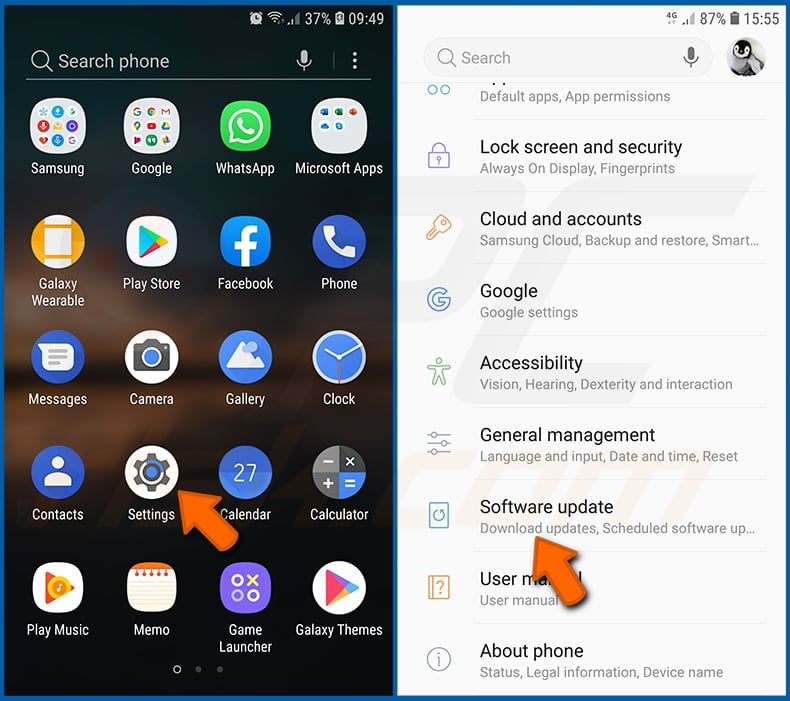
Go to "Settings", scroll down until you see "Software update" and tap it.
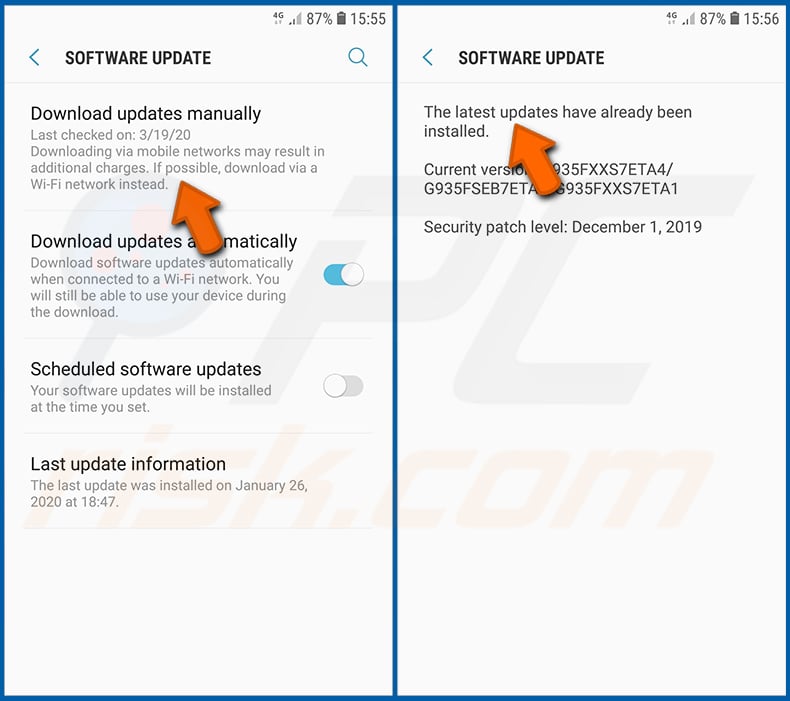
Tap "Download updates manually" and check if there are any updates available. If so, install them immediately. We also recommend to enable the "Download updates automatically" option - it will enable the system to notify you once an update is released and/or install it automatically.
Reset the system to its default state:
Performing a "Factory Reset" is a good way to remove all unwanted applications, restore system's settings to default and clean the device in general. However, you must keep in mind that all data within the device will be deleted, including photos, video/audio files, phone numbers (stored within the device, not the SIM card), SMS messages, and so forth. In other words, the device will be restored to its primal state.
You can also restore the basic system settings and/or simply network settings as well.
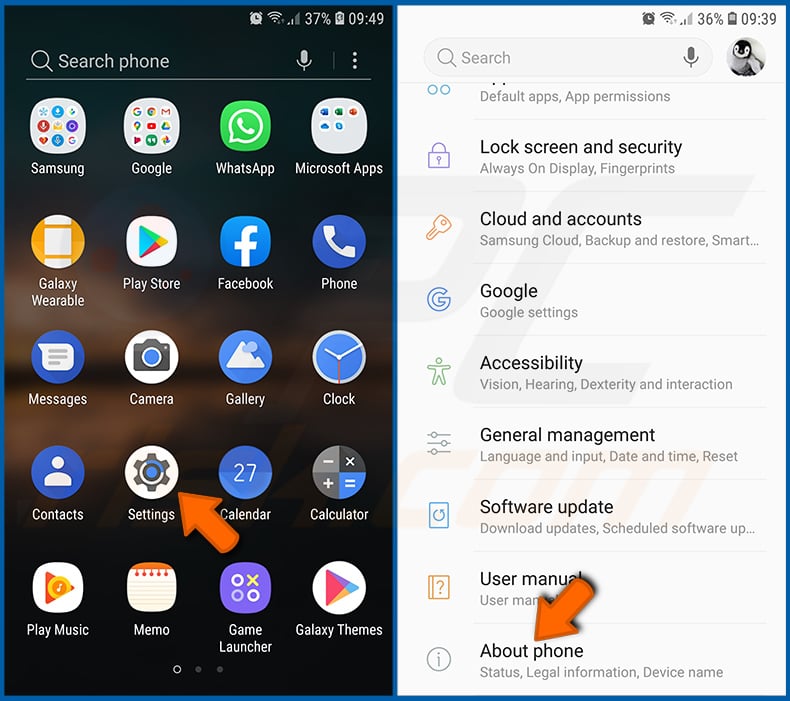
Go to "Settings", scroll down until you see "About phone" and tap it.
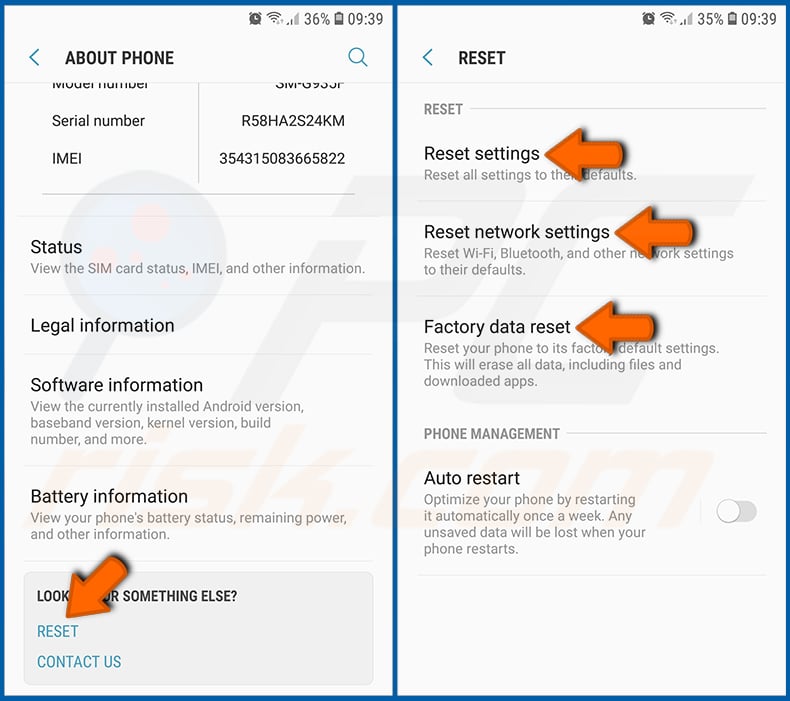
Scroll down until you see "Reset" and tap it. Now choose the action you want to perform:
"Reset settings" - restore all system settings to default;
"Reset network settings" - restore all network-related settings to default;
"Factory data reset" - reset the entire system and completely delete all stored data;
Disable applications that have administrator privileges:
If a malicious application gets administrator-level privileges it can seriously damage the system. To keep the device as safe as possible you should always check what apps have such privileges and disable the ones that shouldn't.
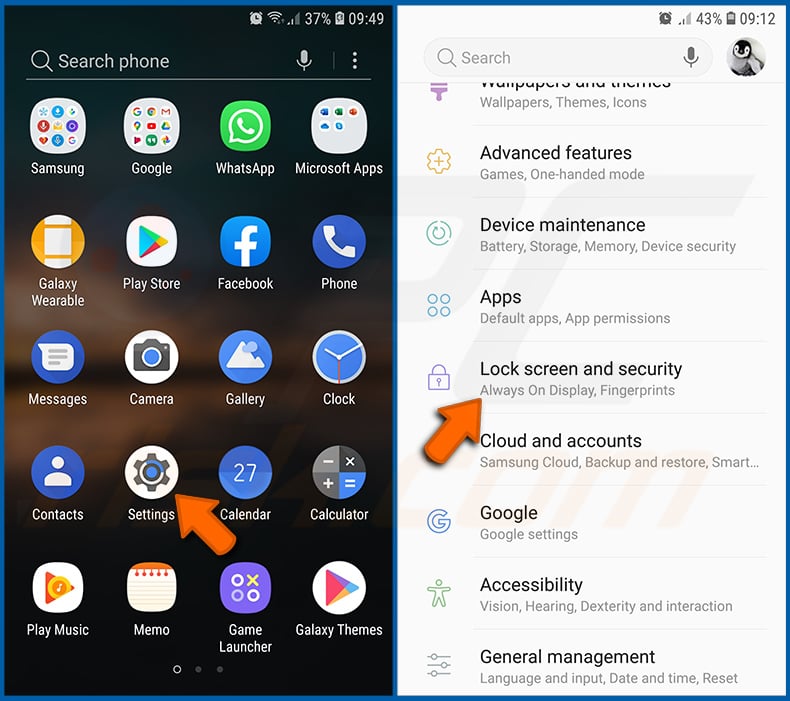
Go to "Settings", scroll down until you see "Lock screen and security" and tap it.
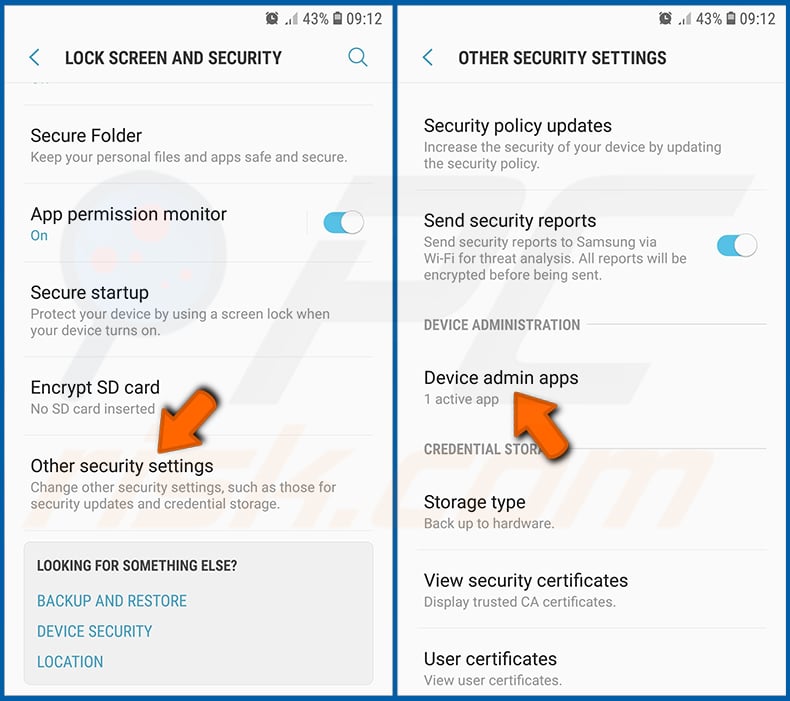
Scroll down until you see "Other security settings", tap it and then tap "Device admin apps".
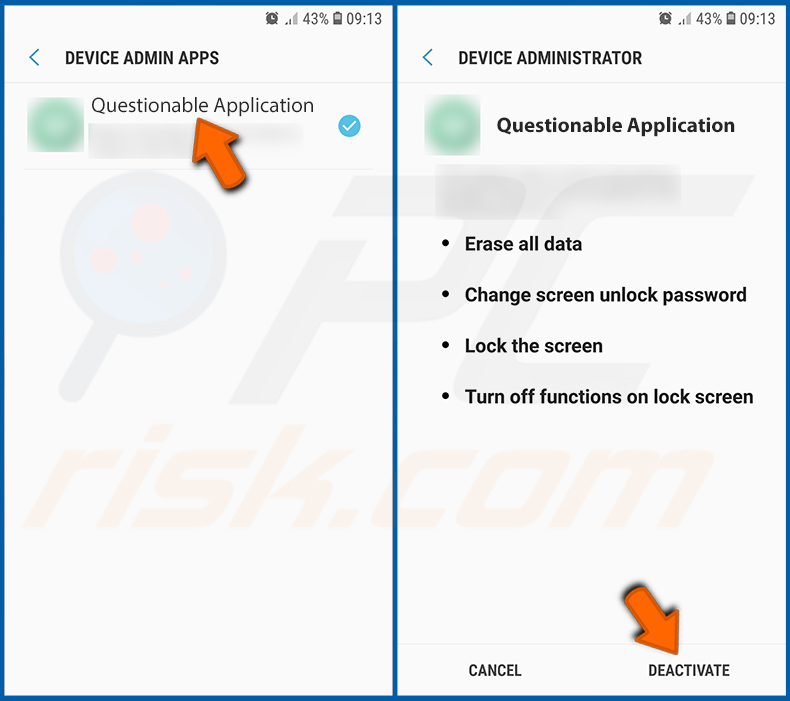
Identify applications that should not have administrator privileges, tap them and then tap "DEACTIVATE".
Frequently Asked Questions (FAQ)
My device is infected with Aesimus malware, should I format my storage device to get rid of it?
Formatting your storage device might remove the Aesimus malware, but it is a drastic measure that also erases all data on your device. Before resorting to this, consider less extreme options, such as using reputable antivirus or malware removal tools like Combo Cleaner.
What are the biggest issues that malware can cause?
Malware can steal sensitive information such as passwords and financial data, leading to identity theft or unauthorized access to accounts. Malware can also manipulate or corrupt system files, causing device instability or rendering it unusable. Furthermore, malware often facilitates other malicious activities, such as launching distributed denial-of-service (DDoS) attacks or spreading further infections.
What is the purpose of Aesimus?
The primary purpose of Aesimus is to perpetrate financial fraud by surreptitiously subscribing victims to premium services without their consent.
How did Aesimus infiltrate my device?
Aesimus likely infiltrated your device through deceptive means, such as disguising itself within seemingly legitimate applications (Pixel Brush, Oil, Watercolor Painting, Paint Board, and Pixel Creation) on Google Play.
Will Combo Cleaner protect me from malware?
Combo Cleaner can identify and eradicate nearly all recognized malware infections. It is important to note that sophisticated malware often conceals itself deeply within the system. Consequently, conducting a comprehensive scan becomes imperative to ensure thorough detection and removal.
Share:

Tomas Meskauskas
Expert security researcher, professional malware analyst
I am passionate about computer security and technology. I have an experience of over 10 years working in various companies related to computer technical issue solving and Internet security. I have been working as an author and editor for pcrisk.com since 2010. Follow me on Twitter and LinkedIn to stay informed about the latest online security threats.
PCrisk security portal is brought by a company RCS LT.
Joined forces of security researchers help educate computer users about the latest online security threats. More information about the company RCS LT.
Our malware removal guides are free. However, if you want to support us you can send us a donation.
DonatePCrisk security portal is brought by a company RCS LT.
Joined forces of security researchers help educate computer users about the latest online security threats. More information about the company RCS LT.
Our malware removal guides are free. However, if you want to support us you can send us a donation.
Donate
▼ Show Discussion